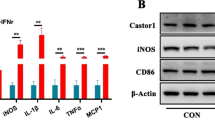Abstract
Microglia can be driven to adopt M1 and M2 phenotypes. While the distinct functions of M1 and M2 microglia have been intensively studied, the former are considered proinflammatory and the latter anti-inflammatory. PGC-1-related coactivator (PRC), an important member in the peroxisome proliferator-activated receptor γ coactivator-1 (PGC-1) family, plays an essential role in metabolic regulation and cell proliferation. The effects of PRC on microglia M2 polarization are still unknown. In this study, we found that PRC expression was robustly induced in M2 microglia. Overexpression of PRC promotes microglia M2 polarization by increasing the expression of arginase-1 (Arg1), resistin-like α (Retnla, Fizz1), and chitinase 3-like 3 (Chi3l3, Ym1). In contrast, the silence of PRC attenuates microglia M2 polarization. Mechanistically, PRC was found to cooperate with signal transducer and activator of transcription 6 (STAT6) to induce an M2 genetic program. Overall, our findings identify PRC as what we believe to be a novel regulator of microglia M2 polarization.






Similar content being viewed by others
References
Ajmone-Cat MA, Mancini M, De Simone R, Cilli P, Minghetti L (2013) Microglial polarization and plasticity: evidence from organotypic hippocampal slice cultures. Glia 61:1698–1711
Andersson U, Scarpulla RC (2001) Pgc-1-related coactivator, a novel, serum-inducible coactivator of nuclear respiratory factor 1-dependent transcription in mammalian cells. Mol Cell Biol 21:3738–3749
Boche D, Perry VH, Nicoll JA (2013) Review: activation patterns of microglia and their identification in the human brain. Neuropathol Appl Neurobiol 39:3–18
Bouhlel MA, Derudas B, Rigamonti E, Dièvart R, Brozek J, Haulon S, Zawadzki C, Jude B, Torpier G, Marx N, Staels B, Chinetti-Gbaguidi G (2007) PPARgamma activation primes human monocytes into alternative M2 macrophages with anti-inflammatory properties. Cell Metab 6:137–143
Chengye Z, Daixing Z, Qiang Z, Shusheng L (2013) PGC-1-related coactivator (PRC) negatively regulates endothelial adhesion of monocytes via inhibition of NF κB activity. Biochem Biophys Res Commun 439:121–125
Crain JM, Nikodemova M, Watters JJ (2013) Microglia express distinct M1 and M2 phenotypic markers in the postnatal and adult central nervous system in male and female mice. J Neurosci Res 91:1143–1151
Eisele PS, Salatino S, Sobek J et al (2013) The peroxisome proliferator-activated receptor γ coactivator 1α/β (PGC-1) coactivators repress the transcriptional activity of NF-κB in skeletal muscle cells. J Biol Chem 288:2246–2260
Gaikwad SM, Heneka MT (2013) Studying M1 and M2 states in adult microglia, Methods. Mol Biol 1041:185–197
Gleyzer N, Vercauteren K, Scarpulla RC (2005) Control of mitochondrial transcription specificity factors (TFB1M and TFB2M) by nuclear respiratory factors (NRF-1 and NRF-2) and PGC-1 family coactivators. Mol Cell Biol 25:1354–1366
Joseph B, Venero JL (2013) A brief overview of multitalented microglia. Methods Mol Biol 1041:3–8
Katsouri L, Blondrath K, Sastre M (2012) Peroxisome proliferator-activated receptor-γ cofactors in neurodegeneration. IUBMB Life 64:958–964
Kobayashi K, Imagama S, Ohgomori T et al (2013) Minocycline selectively inhibits M1 polarization of microglia. Cell Death Dis 4:e525
Lawrence T (2009) The nuclear factor NF-kappaB pathway in inflammation. Cold Spring Harb Perspect Biol 1:a001651
Pauleau AL, Rutschman R, Lang R, Pernis A, Watowich SS, Murray PJ (2004) Enhancer-mediated control of macrophage-specific arginase I expression. J Immunol 172:7565–7573
Perry VH, Nicoll JA, Holmes C (2010) Microglia in neurodegenerative disease. Nat Rev Neurol 6:193–201
Ponomarev ED, Maresz K, Tan Y, Dittel BN (2007) CNS-derived interleukin-4 is essential for the regulation of autoimmune inflammation and induces a state of alternative activation in microglial cells. J Neurosci 27:10714–10721
Scarpulla RC, Vega RB, Kelly DP (2012) Transcriptional integration of mitochondrial biogenesis. Trends Endocrinol Metab 23:459–466
Sheng B, Gong K, Niu Y et al (2009) Inhibition of gamma-secretase activity reduces Abeta production, reduces oxidative stress, increases mitochondrial activity and leads to reduced vulnerability to apoptosis: implications for the treatment of Alzheimer’s disease. Free Radic Biol Med 46:1362–1375
Shi H, Sheng B, Zhang F, Wu C, Zhang R, Zhu J, Xu K, Kuang Y, Jameson SC, Lin Z, Wang Y, Chen J, Jain MK, Atkins GB (2013) Kruppel-like factor 2 protects against ischemic stroke by regulating endothelial blood brain barrier function. Am J Physiol Heart Circ Physiol 304:H796–H805
Sica A, Bronte V (2007) Altered macrophage differentiation and immune dysfunction in tumor development. J Clin Invest 117:1155–1166
Vats D, Mukundan L, Odegaard JI, Zhang L, Smith KL, Morel CR, Wagner RA, Greaves DR, Murray PJ, Chawla A (2006) Oxidative metabolism and PGC-1beta attenuate macrophage-mediated inflammation. Cell Metab 4:13–24
Vercauteren K, Pasko RA, Gleyzer N, Marino VM, Scarpulla RC (2006) PGC-1-related coactivator: immediate early expression and characterization of a CREB/NRF-1 binding domain associated with cytochrome c promoter occupancy and respiratory growth. Mol Cell Biol 26:7409–7419
Yoshimura A (2006) Signal transduction of inflammatory cytokines and tumor development. Cancer Sci 97:439–447
Zhou F, Zhang L, Gong K, Lu G, Sheng B, Wang A, Zhao N, Zhang X, Gong Y (2008) LEF-1 activates the transcription of E2F1. Biochem Biophys Res Commun 365:149–153
Zhou G, Hamik A, Nayak L, Tian H, Shi H, Lu Y, Sharma N, Liao X, Hale A, Boerboom L, Feaver RE, Gao H, Desai A, Schmaier A, Gerson SL, Wang Y, Atkins GB, Blackman BR, Simon DI, Jain MK (2012) Endothelial Kruppel-like factor 4 protects against atherothrombosis in mice. J Clin Invest 122:4727–4731
Author information
Authors and Affiliations
Corresponding author
Additional information
Chengzhi Mou and Bin Liu contributed equally to this work.
Rights and permissions
About this article
Cite this article
Mou, C., Liu, B., Wang, M. et al. PGC-1-Related Coactivator (PRC) Is an Important Regulator of Microglia M2 Polarization. J Mol Neurosci 55, 69–75 (2015). https://doi.org/10.1007/s12031-014-0315-6
Received:
Accepted:
Published:
Issue Date:
DOI: https://doi.org/10.1007/s12031-014-0315-6




